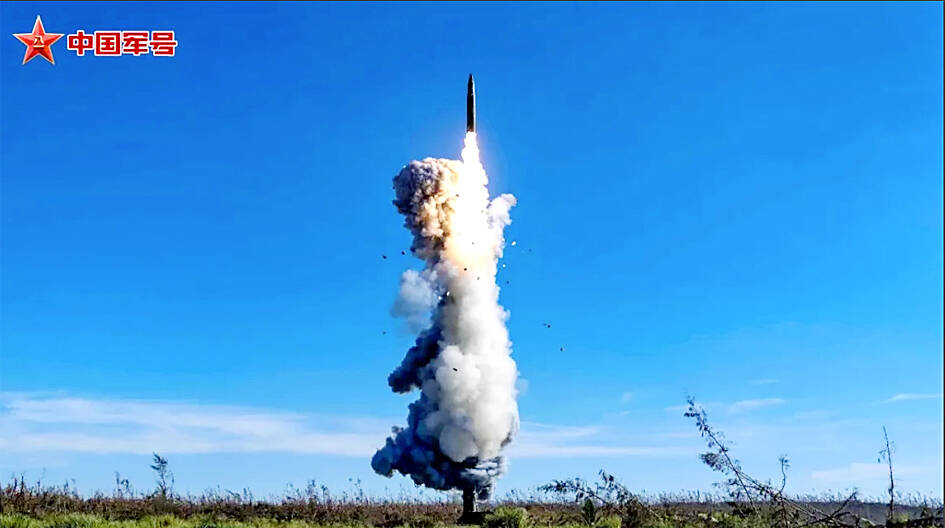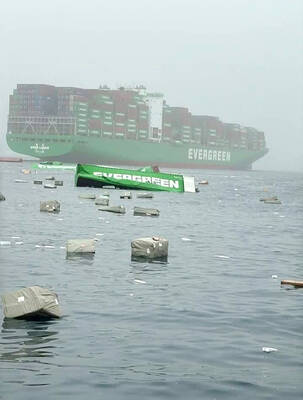China’s rare test-firing of an intercontinental ballistic missile (ICBM) into the Pacific Ocean on Wednesday was likely intended to send a message of deterrence to the US, analysts said.
An ICBM carrying a dummy warhead was launched at 8:44am on Wednesday as part of a routine training exercise by the Chinese People’s Liberation Army (PLA) Rocket Force, the Chinese Ministry of Defense said.
The missile fell into “expected sea areas” in the Pacific Ocean, the ministry said, without specifying an exact location.

Photo: screen grab from Chinese People’s Liberation Army’s Weibo account
Authorities in French Polynesia later said that the missile had landed in waters near the island’s exclusive economic zone, and that China had sent advance notification to France.
That was the first time in 44 years that China launched an ICBM into the Pacific Ocean, Institute for Defense and Security Research associate research fellow Shu Hsiao-huang (舒孝煌) said.
China typically tests long-range missiles over its own territory. It last launched an ICBM into the South Pacific in 1980.
The launch was likely intended as a message to the US, which has steadily expanded its presence in the Indo-Pacific region in recent years, putting pressure on China, Shu said.
Beijing, in turn, has formed an alliance and increasingly conducts joint military exercises with Russia, he said.
As for the logic and timing of the test, in an era of “great power competition,” countries need to continually improve their strategic deterrence capabilities, he added.
Beijing might also have wanted to show that the PLA Rocket Force’s readiness has not been negatively impacted after several of its senior leaders were removed during an anti-graft purge last year, Shu said.
Based on images released by the PLA, the ICBM used in the test launch was likely a Dongfeng-31 AG, which has a range of about 12,000km, Tamkang University’s Center for Advanced Technology researcher Yang Tai-yuan (楊太源) said.
China also has Dongfeng-41 and JL-3 ICBMs, which have ranges of more than 13,500km and are capable of reaching the US east coast, Yang said.
For that reason, Wednesday’s test launch sends a message to Washington that Beijing still has nuclear second-strike capabilities and possesses the ability to deter US intervention if a war broke out in the Taiwan Strait, Yang said.

The Executive Yuan yesterday approved a southwestern extension of the Sanying MRT Line from New Taipei to Bade District (八德) in Taoyuan, with a goal of starting construction by late 2026. The 4.03-kilometer extension, featuring three new stations, will run from the current terminus at Yingtao Fude Station (LB12) in New Taipei City to Dannan Station (LB14), where it will connect with Taoyuan’s Green Line, New Taipei City Metro Corp said in a statement. This extension will follow the completion of core Sanying Line, a 14.29-kilometer medium-capacity system linking Tucheng (土城), Sansia (三峽)

CARGO LOSS: About 50 containers at the stern of the ‘Ever Lunar’ cargo ship went overboard, prompting the temporary closure of the port and disrupting operations Evergreen Marine Corp, Taiwan’s largest container shipper, yesterday said that all crew members aboard the Ever Lunar (長月) were safe after dozens of containers fell overboard off the coast of Peru the previous day. The incident occurred at 9:40am on Friday as the Ever Lunar was anchored and waiting to enter the Port of Callao when it suddenly experienced severe rolling, Evergreen said in a statement. The rolling, which caused the containers to fall, might have been caused by factors including a tsunami triggered by an earthquake in Russia, poor winter sea conditions in South America or a sudden influx of waves,

The Ministry of Culture yesterday officially launched the “We TAIWAN” cultural program on Osaka’s Nakanoshima sandbank, with the program’s mascot receiving overwhelming popularity. The cultural program, which runs from Aug. 2 to 20, was designed to partner with and capitalize on the 2025 World Expo that is being held in Osaka, Japan, from April 13 to Oct. 13, the ministry said. On the first day of the cultural program, its mascot, a green creature named “a-We,” proved to be extremely popular, as its merch was immediately in high demand. Long lines formed yesterday for the opening

The Taipei Summer Festival is to begin tomorrow at Dadaocheng Wharf (大稻埕), featuring four themed firework shows and five live music performances throughout the month, the Taipei Department of Information and Tourism said today. The festival in the city’s Datong District (大同) is to run until Aug. 30, holding firework displays on Wednesdays and the final Saturday of the event. The first show is scheduled for tomorrow, followed by Aug. 13, 20 and 30. To celebrate the 30th anniversary of Disney Pixar's movie Toy Story, the festival has partnered with Walt Disney Co (Taiwan) to host a special themed area on